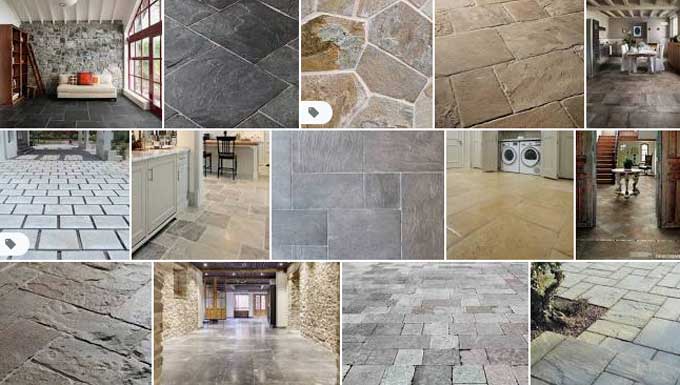
A Description of the Properties, Advantages, and Disadvantages of Natural Stone Flooring

Natural stone is the most elegant and luxurious type of flooring. Unlike synthetic or manufactured stone products, natural minerals found in the mountains call Natural Stone.
Slate, marble, limestone, travertine, granite, and sandstone are some of the common natural stone flooring types. Each of these stones has slightly different characteristics. It is important to understand its characteristics to determine whether a particular stone flooring tile is appropriate for a given location. These are a few general factors to keep in mind as you shop for natural stone tiles.
Properties of Stone Flooring
Natural Stone Grade
Natural stone flooring materials rate according to a standard grade system. According to the grade, sizes, shapes, thicknesses, and conditions of a surface considers.
- Natural stones classified as Grade-1 have a higher quality and uniform composition.
- The grade-2 type of natural stone includes materials that have surface irregularities and scratches.
- The surface, size, or shape of natural stone materials graded 3 are usually defective, making them only useful for decorative purposes.
Absorption Rate of Natural Stones
Natural stones absorb water at a rapid rate, showing they are porous. Under freezing conditions, surfaces with a high absorption rate tend to stain and crack more easily. Polishing a floor can decrease the rate of water absorption.
Natural stones differ in their porous state, with sandstone being the most porous and granite being the least porous. The water absorption rate of travertine, limestone, and slate is medium.
Vitreous Natural Stones
The absorption rate of these stones is standard for flooring tiles, and they suit for applications in and outside with low to medium traffic.
Semi-Vitreous Natural Stones
Liquids increase the maintenance of these less absorbent materials.
Non-Vitreous Natural Stones
Natural stones such as these know for their high absorption capacity, so damp environments are not recommended.
Impervious Stone
It is easy to maintain these stones, which do not absorb liquids. Commercial applications with high traffic highly recommend.
Friction Coefficient of Natural Stones
Different flooring materials have different coefficients of friction. It has more traction if the coefficient is higher. In high-traffic commercial areas, bathroom areas, and kitchens, the importance of this measurement is more apparent. Flooring materials should have a dryness coefficient of at least 0.6.
Oxidation of Natural Stones
Natural stones compose of a variety of elements originating beneath the earth. When exposed to the outdoor environment, the iron in the natural stones oxidizes, resulting in rusting. The deterioration of the entire tile can cause by rust.
Advantage of Natural Stones
There is a unique creation in every natural stone. The natural color and texture of natural stones give the floor space a warm appearance. Nature-friendly and eco-friendly are the advantages of natural stones.
Disadvantage of Natural Stones
The surfaces of all-natural stones, except granite and some unique slate stones need to be sealed to prevent stains. Marbles and other natural stones are prone to scratches. Stones found in natural settings are often brittle and prone to breaking.
Wrapping it Up
Building construction with natural stones is the most luxurious and elegant option. In comparison with artificial stone products, they are quarried directly from the earth and have superior properties. Floors are primarily made of marble, granite, limestone, sandstone, slate, and travertine.
To learn more, watch the following video tutorial.
Video Source: Science Channel
Understanding the characteristics and features of natural stones allows us to determine if they are suited to a specific location. To select the right natural stone for your flooring project, thoroughly examine its characteristics as well as its suitability and maintenance requirements.


